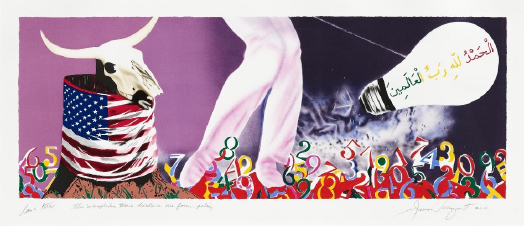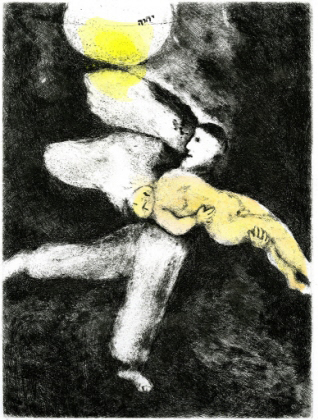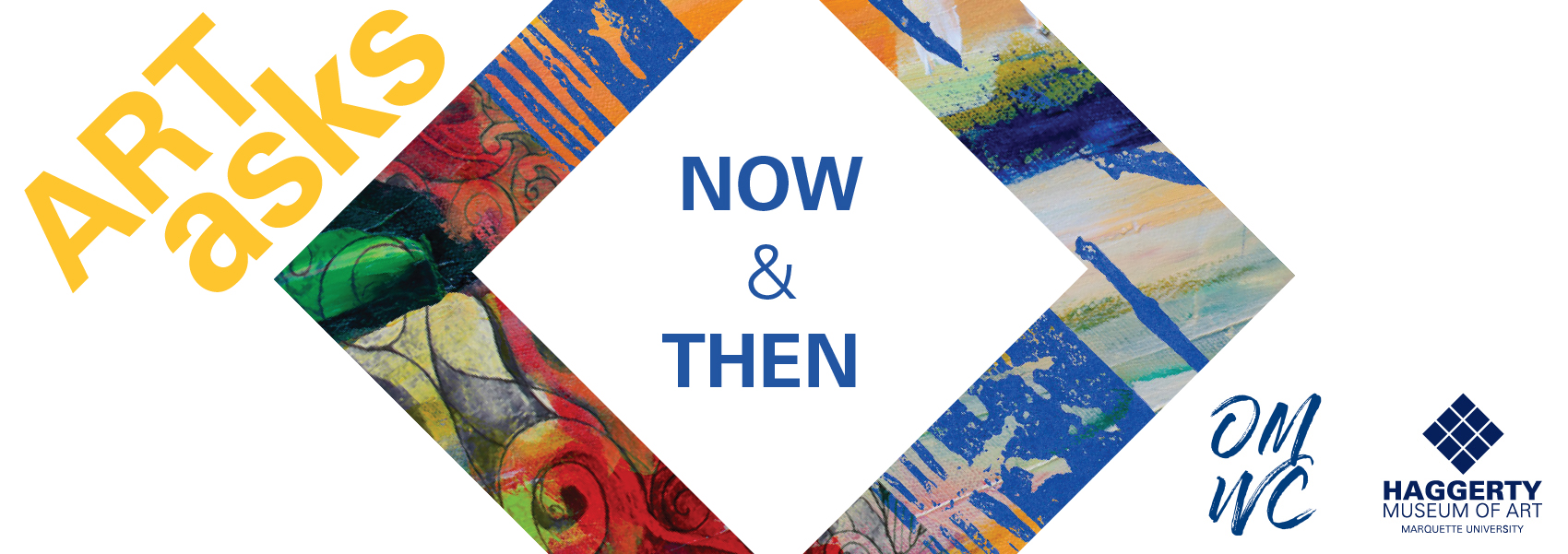
James Rosenquist (American, 1933-2017), The Xenophobic Movie Director or Our Foreign Policy, 2011.

Marc Chagall (French, born Belarus, 1887 – 1985), Creation of Man from the series Bible, 1958.
Each work of art welcomes us into a world of the artist’s devising. Paintings and prints welcome us with color and shape as well as line, light, and space. When two or more works appear together, they enter into conversation. Together, their styles and symbolism prompt a dialogue of ideas and emotions in the minds of everyone who views them.
For September 2021, we bring together two prints. Take a moment to study them.
At first, their differences may stand out. The former is firmly set in the twenty-first century. It’s a lithograph based on a painting by James Rosenquist titled The Xenophobic Movie Director or Our Foreign Policy. The lithograph was made in 2011, but the painting was made in 2004, during the first presidential election that took place after the September 11th terrorist attacks. The latter is a hand-colored etching by Marc Chagall. It’s from a mid-twentieth-century series called Bible, which depicts scenes from the Old Testament. This work is Chagall’s response to Genesis, 2:7: “The Lord God formed man from the dust of the earth. He blew into his nostrils the breath of life, and man became a living being.”
Art Asks: Now & Then
Post and tag your writing with #ArtAsks #HMA #OttWC
Prompt 1 (5-15 minutes)
Sometimes when we look at a work of art, we trigger one or more of our other senses. This phenomenon is known as synesthesia. Some people have synesthetic responses all the time: they taste sounds or they hear textures. Some people rarely if ever have this experience.
For this prompt, we invite you to imaginatively combine your senses so that you can both look at and listen to this month’s artworks.
- (Five minutes) Pick one of the two prints on display, and spend a couple of minutes looking at it. Notice not only what objects are included but also what colors are used and how space is arranged. Notice what your eye is most drawn to, and notice how the print makes you feel.
Next, shift gears and spend a couple of minutes imaginatively listening to the print you chose. What do you hear? Sounds or music? Individual words or phrases? Whole sentences or dialogue among objects or colors? Or something else?
Spend one minute sharing “what you heard” on Twitter: #ArtAsks #HMA #OttWC.
- (Five minutes) Repeat the steps above with the other print.
- (Five minutes) Put the two prints into conversation. You might describe the music they make together, or you might write a song. Or you might write a poem or narrative with dialogue. Feel welcome to email what you write to the Haggerty and the Ott.
Prompt 2 (15 minutes)
Often, we talk about looking at art in contrast to reading written and printed works. What happens if we try to read James Rosenquist’s lithograph, The Xenophobic Movie Director or Our Foreign Policy?
- (5 minutes) Set a timer for 5 minutes, and focus on reading this print or making sense of not only what is in it but also what it is saying. Working from left to right, try to identify three or four images that are included. Write them down. Knowing what you do about Rosenquist’s work, including the title, think about how you might decode these symbols to discern their meaning.
Hints: Longhorn skull (possible allusion to President Bush’s home state of Texas), American flag (patriotism, but instead of flying the flag is used to cover or conceal), tree stump (the remnant of something that has been razed, or perhaps an allusion to President Bush’s oft-criticized activity of clearing brush while on vacation at his Crawford, TX ranch), numbers, golf stance (a leisure activity, but also a reference to “teeing” up, meaning preparing for imminent action), light bulb (an idea).
- (5 minutes) You may have noticed the Arabic words inscribed on the light bulb, which translate, “Praise God Creator of Our Worlds.” Since Arabic is read from right to left, we might say the print is inviting us to also read from right to left. Set a timer and try reading this print in that direction.
- (5 minutes) Set a timer and write down what (if anything) seemed different to you when you read in different directions. What (if anything) seemed the same? Also consider whether and how changing your perspective by changing how you read did or did not change your overall experience of the piece. Did you feel the same way about this print? Can you explain your answer?
Prompt 3 (10 minutes)
What happens if, similar to Prompt 2, we try to read Chagall’s etching, Creation of Man?
- (5 minutes) Set a timer for 5 minutes, and focus on reading this work or discerning what is in it and interpreting what it is saying. Working from left to right, identify what is included in it and what appears to be happening. Consider how this etching does or does not communicate its title phrase, “creation of man.”
- (5 minutes) You may notice an orb at the top of the composition which, like Rosenquist’s light bulb, contains writing. In this case, the writing is Hebrew. It spells out the Hebrew word for God, “YHWH.” Since Hebrew is read from right to left, set a timer for 5 minutes and reread this print, looking from right to left.
- (5 minutes) Set a timer and write down what (if anything) seemed different to you when you read in different directions. What (if anything) seemed the same? Also consider whether and how changing your perspective by changing how you read did or did not change your overall experience of the piece. Did you feel the same way about this print? Can you explain your answer?
Prompt 4 (5-10+ minutes)
Both Rosenquist’s and Chagall’s prints contain references to G-d as Creator. Christianity as well as Judaism and Islam are monotheistic, Abrahamic faiths, meaning they share foundational texts that tell the story of Abraham.
- (5+ minutes) Spend 5 or more minutes recalling or researching the story of Abraham. Take notes, and also take note of which faith or faiths you draw on for the version of the story you write down.
- (5+ minutes) Spend 5 or more minutes comparing and contrasting the way the two prints illustrate and/or comment on faith in general as well as one or more of the Abrahamic faiths.
Prompt 5 (10+ minutes)
September 11, 2021 marks the 20th anniversary of the terrorist attacks that took place in the United States on 9/11 in 2001. In the aftermath of that event, many people turned to their faith for immediate solace as well as long-term support. Religion and religious extremism were also associated with 9/11, including not only the attacks themselves but also both personal and collective responses to them. Across the US, interfaith services contrasted sharply with the rise in hate speech and hate crimes committed against Muslims.
In the spirit of “Now and Then,” which is the Art Asks theme this semester, try one or more of the following exercises:
- (5+ minutes) Think about what the 20th anniversary of 9/11 means to you, and then spend 5 minutes (or as much time as you need) looking at, meditating on, and generally communing with these prints as a way to intentionally observe this year’s 9/11 anniversary.
- (5+ minutes) Think about the relationship between the present and past, especially the relationship between us now and art from "then," whether the early twenty-first century, the mid-twentieth century, or earlier periods of time. Focusing on this month’s prints, do you believe art can help us remember and address difficult subjects, like 9/11? Why or why not? How else can—and should—we consider these works and others on exhibit at the Haggerty.
Set a timer for 5 minutes and write out your thoughts. Repeat this activity for as long as you like, and feel welcome to share what you write with the Haggerty and the Ott: #ArtAsks #HMA #OttWC.




